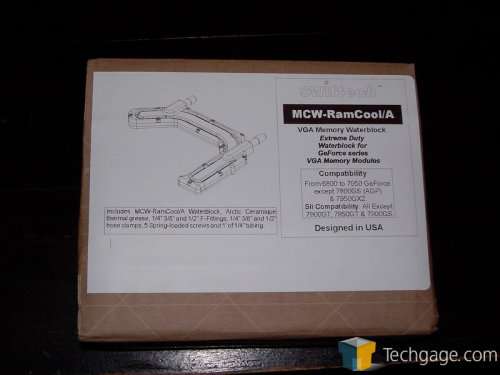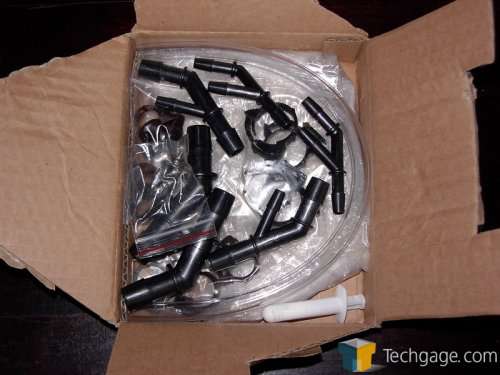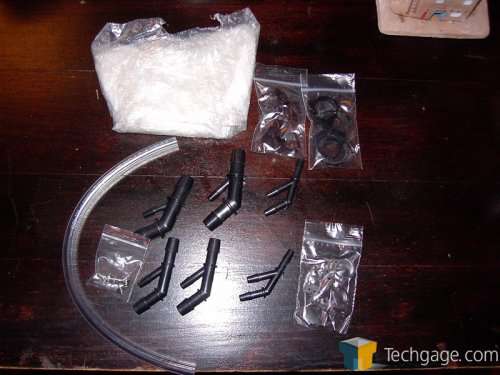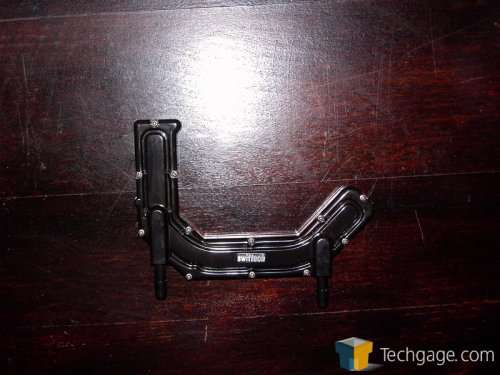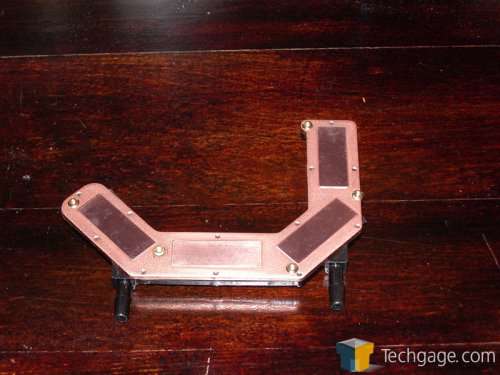- Qualcomm Launches Snapdragon 4 Gen 2 Mobile Platform
- AMD Launches Ryzen PRO 7000 Series Mobile & Desktop Platform
- Intel Launches Sleek Single-Slot Arc Pro A60 Workstation Graphics Card
- NVIDIA Announces Latest Ada Lovelace Additions: GeForce RTX 4060 Ti & RTX 4060
- Maxon Redshift With AMD Radeon GPU Rendering Support Now Available
Swiftech MCWRamcool
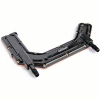
One of the drawbacks of full graphics card water blocks is that they don’t always fit the cards being used like they should. There are tolerance issues depending on the height of the ram versus the height of the GPU. Swiftech offers a cure to those ills with the MCWRamcool.
Page 1 – Introduction
|
|
When performance is your goal you often go to extremes to wring as much of it from your equipment as you possibly can. Quite often it involves the black art of overclocking and this is where your thermodynamics can make or break you. Face it, if your case won’t cool well you could have the noodliest equipment with the wildest headroom around and it won’t OC worth a damn.
A mediocre CPU will out clock an extremely good core at near ambient temp if the good core is at 50C or above. We’re starting to see ram that benefits from good cooling such as active cooling or water cooling by rewarding us with very good overclocks. I’ve heard a lot of debate over water cooled ram and I have to say I’m sold! I took a box stock 7950 and pushed it to the point that it went into "Emergency 3D Mode" on air and surpassed the clocks that it failed at previously by a very good margin by switching to full water cooling on the card.
I’ll get into greater detail on this later in the review. First let’s hear what Swiftech has to say about the MCWRamcool.
The MCW-Ramcool series are extreme duty waterblocks designed to fit nVidia’s GeForce series VGA memory modules. The design concept is a standalone solution mechanically distinct from the GPU waterblock. For this reason the MCW-Ramcool waterblocks guarantee superior thermal joints with the memory modules compared to stock or to other aftermarket "monolithic" cooling solutions. This can translate into superior performance and overclockability of the memory modules.
In order to provide universal compatibility with existing liquid cooling systems, we have designed the Patent Pending "F" fittings which allow the MCW-Ramcool to operate with 1/2", 3/8" and 1/4" cooling loops. These fittings provide a clean tube routing, with a minimum of pressure drop in the system by linking in parallel the 1/4" MCW-Ramcool ports to the VGA water-block ports.
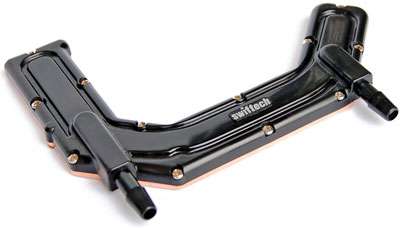
I won’t go into greater detail because it gives you the general idea but if you’re interested, Swiftech has more details and a flow chart showing pressure drop data.
The box is a simple corrugated paper (commonly known as cardboard, but it’s not…really) with a printed label showing a line illustration of the block. For some reason this is typical of the higher end American water cooling companies out there. The stuff from overseas uses flashier box art but box art doesn’t mean much.
It’s what’s inside the box that matters. Inside there are 3 pair of "F" fittings, clamps for the "F" fittings, a short section of 1/4" tubing, thermal paste and the block and mounting hardware. The "F" fittings are unique, there are no 90’s to slow down flow. Instead the water exits at a 45* angle to the original direction of flow. This creates a marginal decrease in flow velocity but the benefit is twofold, the smaller tubing exiting at that angle gets flow sheared off as it flows over the oblong hole with the sharp pronounced corner that is created as a result and the main tubing going into that bend creates enough back-pressure to help multiply that effect.
On the outlet side we have the pump drawing water into itself and that bend helps to cause the pump to draw water through that smaller tube through a venturii effect as there’s little resistance to the water joining the flow and again, the bend multiplies the effect of the 45* angle of the smaller tube. If you blow on the end of a straw at 90* you wont see much action, the air has hardly any time to enter the straw and create either pressure or suction. Blow across the same straw at a 45* angle to the air flow and you’ll either blow bubbles in your Coke or piss off the better half because you’ll have jetted Coke all over her.
Here’s a look at the ramblock in the flesh. Pretty nicely made in my opinion, the fittings are molded in place but to save space that’s the price you pay. That allows for no clearance issues and doesn’t force the fittings to stick out past the edge of the card by a large margin. If the fittings screwed in, the bolsters you see them mounted to would have to nearly triple in size.
As it stands, they’re over the card in one location and right to the edge of it in the other as you’ll see. Looking at the underside reveals the the pads for the ram, note that like everything else Swiftech sells, they’re not mirror polished, just machine lapped. I’m of the school of thought that mirror polishing is bad in that it impedes heat transfer by not allowing the thermal compound to get pulled up into the fissures in the finish thereby causing a thicker layer of compound. Thicker compound acts as a blanket and becomes a thermal barrier.
|
|
Support our efforts! With ad revenue at an all-time low for written websites, we're relying more than ever on reader support to help us continue putting so much effort into this type of content. You can support us by becoming a Patron, or by using our Amazon shopping affiliate links listed through our articles. Thanks for your support!




